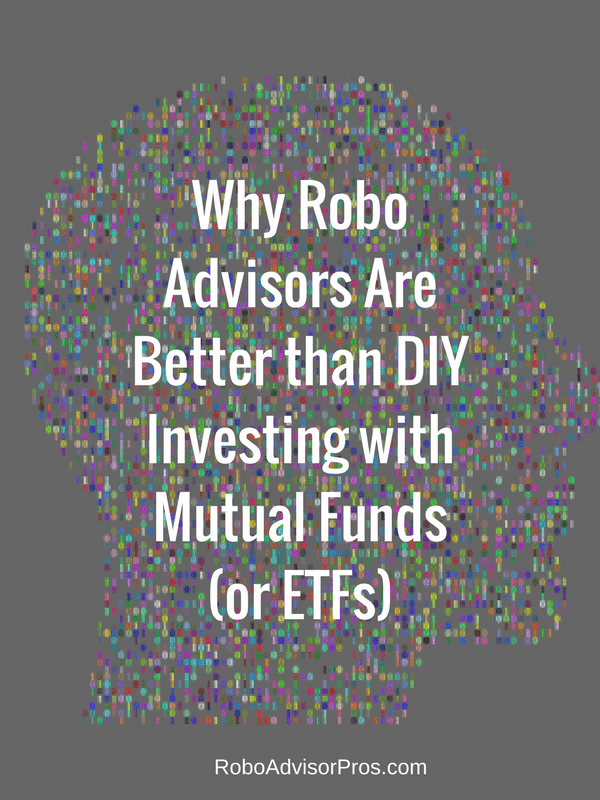Robo-Advisor or DIY – Why Robo-advisors are Better than DIY Investing with Mutual Funds (or ETFs)
Investors sometimes question the need for investing with robo-advisors. After all, robo-advisors mostly invest in funds, particularly exchange traded funds (ETFs). Isn’t that something that you could do for yourself? It’s not exactly that simple. Robo-advisors are better than DIY investing with mutual funds or ETF’s, because they use algorithms to determine the precise mix of funds that are held in your portfolio. With these algorithms, you’re likely to earn the greatest returns for your individual risk comfort level.
DIY investing can be a difficult balancing act even for a sophisticated investor. What’s more, robo-advisors provide certain investment management benefits that many investors prefer.
Let’s take a look at both sides of the robo-advisor or DIY debate.

The Typical Arguments in Favor of DIY Investing with Mutual Funds or ETFs
In theory at least, you can invest most of your money in an ETF that’s based on the S&P 500, and a minority percentage in a diversified bond index fund. That would approximate the return from a robo-advisor, while eliminating the annual management fee, which typically runs between 0.25% and 0.50% of your portfolio. (Although M1 Finance, Schwab and Wisebanyan don’t charge management fees.) That means that you fully expect to earn an additional one-quarter to one-half percent on your investments each year.
So far so good.
You can even push the envelope by investing 100% of your money in an S&P 500 fund during bull markets, to increase your returns still more. After all, the average annual compound return on the S&P 500 has been something on the order of 10% going all the way back to 1928.
Maybe, in a perfect world. But as we all know, this isn’t a perfect world. And that’s why DIY investing – even through mutual funds and ETF’s – isn’t the best choice.
In the robo-advisor or DIY debate, let’s look at why robo-advisors are the better investment solution for most investors.
Not Everyone Understands Investing, or is Comfortable “Going Solo”
The vast majority of adults in America have little or no investment experience. Even many long-term investors have done so only through professionally managed accounts, and lack actual hands-on experience.
As well, many lack confidence in their own investment skills – perhaps as a result of real-world experience. That lack of confidence isn’t unfounded.
A report from S&P Dow Jones Indices based on 2016 revealed this disturbing finding:
” Given that active managers’ performance can vary based on market cycles, the newly available 15-year data tells a more stable narrative. Over the 15-year period ending Dec. 2016, 92.15% of large-cap, 95.4% of mid-cap, and 93.21% of small-cap managers trailed their respective benchmarks.”
This report is significant. It means that even people who invest money for a living, are far more likely to underperform the market. These are well-paid investment professionals who run actively managed mutual funds, that have a primary goal of outperforming the market. Far from outperforming it, roughly 95% underperform it.
That’s embarrassing for professional fund managers. But for DIY investors, the stakes are much higher. Inability to successfully manage a portfolio can result in losing money.
This can happen even if you invest through funds. Even with index funds, you can lose money if you’re too heavily invested in equities at market tops. Conversely, you could lose money if you’re too heavily invested in bonds at the beginning of a new bull market.
Then there’s the possibility of getting caught in specific industry sectors. In an attempt to outperform the general market, you may bet too heavily on sectors like emerging markets or high-tech. Should either of those sectors be caught in a sector-specific downdraft, you can lose money, even if the general market is rising.
Hands-Off Investment Management in the Robo-Advisor or DIY Conversation
Successful investing requires more time than most people realize, or have time for. Robo-advisors reduce investing to one simple step: funding your account. And that can be done on automatic pilot, through regular payroll contributions.
That means that you can fund your account – and have it managed – without any input on your part.
That’s a powerful draw. It enables you to get on with the rest of your life, without the need to watch and manage your portfolio.
Wealth-building does involve a certain number of trade-offs. Sure, paying a quarter or half percent each year for management fees can reduce the return on your investment. But you also have to think in terms of the extra time that it buys you. For a fraction of a percent, you can avoid spending several hundred hours per year watching and managing your investments.
That can be an important benefit if you’re self-employed, earn commission income, or work a considerable amount of paid over-time. The time that you aren’t spending managing your portfolio can be devoted to other income earning opportunities, like your primary occupation.
Let’s look at an example. Let’s say you have a $100,000 portfolio that you will manage for yourself. You will spend approximately 10 hours per week – 500 hours per year – in that effort. Now if you earn $30 an hour working in your business, earning commissions, or working overtime, the 500 hours that you spend on your portfolio will have an opportunity cost a $15,000 (500 hours X $30).
That’s the price you will pay in order to save $500 (0.50%) to have your $100,000 portfolio managed through a robo-advisor. Managing your own investments will actually cost you $14,500.
That’s a price that a lot of people don’t want to pay. How about you?
Robo-Advisor or DIY – The Diversification Advantage
As noted earlier, DIY investors have an unfortunate tendency to be over-invested at market tops, and under-invested at market bottoms. The core problem is a lack of proper diversification. Regardless of market conditions, you need an adequate asset allocation that splits your portfolio between equities and fixed income securities.
Yes, high equity participation enables you to maximize returns on the way up. But fixed income allocations protect you on the way down. They may be boring during bull markets, but they’re absolutely necessary. As well, given that it’s impossible to time markets, you have to be ready for a sudden and dramatic shift at any time. There’s nothing guaranteed or fully predictable about the financial markets!
Most DIY investors underestimate the importance of diversification. In addition, they totally ignore the importance of risk tolerance. That mostly describes your ability to weather a serious downturn in the market. It takes into consideration both your emotional ability to cope with losing money, as well as the other assets you have available.
Robo-advisors have the advantage of doing this impartially. Virtually every one of them has some sort of questionnaire that measures your risk tolerance, as well as your time horizon and investment goals. These can be completely ignored by DIY investors, who lean toward greed in rising markets, and panic in falling markets.
Robo-advisors build diversification into your portfolio. You’re determined to be a certain classification of investor – conservative, moderate, balanced, moderately aggressive, or aggressive. Your portfolio is built around that classification, and includes appropriate allocations in both equities and bonds.
What’s more, your portfolio is generally rebalanced once those allocations get out of sync. It all happens automatically, which removes the emotional component. That’s the best way to weather the ups and downs of the market.
Robo-advisor Niche Platforms
As the number of robo-advisors has grown, so have specializations. Sure, you have robo-advisors that invest in the general market, such as Betterment and Wealthfront. But there are also robo-advisors with special niches.
For example, Ellevest is a robo-advisor that invests specifically with the needs and challenges of woman in mind. M1 Finance enables you to create custom portfolios, that include both ETF’s and individual stocks. And both M1 Finance and Betterment offer socially responsible investing options, that enable you to invest your money consistent with your beliefs.
Another very interesting niche is Hedgeable. The platform offers investing using hedging strategies, the kind employed by very sophisticated investors. The problem is that this type of investing has traditionally been available only to large investors, and requires high fees. Hedgeable provides similar strategies to investors with as little as $1 to invest, and fees ranging from 0.30% to 0.75%. It’s an investment strategy that includes alternative investments, and seeks to minimize portfolio losses in market downturns.
Wealthsimple is taking niche rob-advising to a new level. They offer their Halal Portfolio, that invests consistent with Islamic law.
These are very unique investment niches. If you tried to match what they do, you’d spend considerably more time managing your portfolio. That’s not to mention the money that you will spend educating yourself to the task.
Increasingly, robo-advisors are filling niches that were traditionally available only to large investors, who could afford to pay the fees to develop very specialized portfolios. Sure, you could probably create matching portfolios. But when you consider the time and cost that will be involved, it will be subject to the law of diminishing returns.
Final Thoughts on Why Robo-advisors are Better than DIY Investing with Mutual Funds or ETFs
In the end, wealth-building comes down to a trade-off between time and money. You have to measure the cost of robo-advisors against the benefits they provide. That of course assumes that you will be able to match their performance going the DIY route. Most investors can’t, and that’s the reason for the rising popularity of robo-advisors.
For most investors, the best strategy will be to have most of their money professionally managed through one or more robo-advisors. They can then keep a small percentage of their holdings for DIY, whether that’s in mutual funds, ETF’s or even individual stocks.
Until you’re able to demonstrate that you can consistently produce better investment returns than robo-advisors, DIY is probably costing you money, and hurting your investment returns. Moral of the story: Robo-advisors have a place in your investment portfolio.
Are you taking advantage of what is probably the biggest investment trend of the 21st Century?

